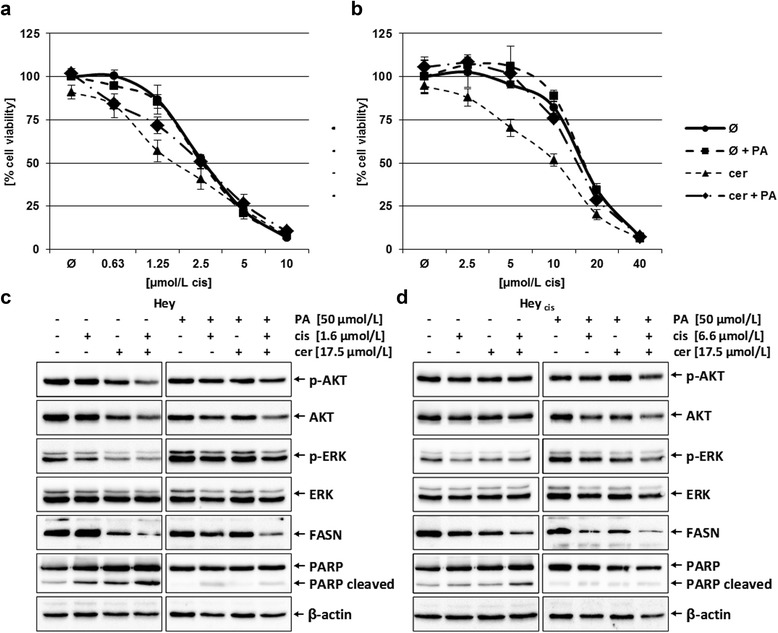Figure 7.

Effect of PA supplementation to combined cerulenin/cisplatin treatment in the Hey (a, c) and cisplatin-resistant Heycis (b, d) cells analyzing cell viability and proliferation and apoptosis. (a, b) Cisplatin was given in various concentrations as a single agent or following administration of 17.5 μmol/L cerulenin in the absence or presence of 50 μmol/L PA. Cell viability was investigated by the MTT assay. The shifted cisplatin IC50 from 2.7 μmol/L to 1.8 μmol/L (33% reduction; P = 0.007) in parental Hey cells after sequential application of cerulenin for 6 h, followed by 72 h incubation in cisplatin-containing media was completely reversed by administration of PA (both cisplatin IC50 of 2.6 μmol/L; P = 0.02) (a). In the Heycis cell line the shifted IC50 from 16.8 μmol/L to 10.5 μmol/L (38% reduction; P = 0.003) was partly abrogated by administration of PA (shifted cisplatin IC50 from 17.1 μmol/L to 15.5 μmol/L (only 9% reduction; P = 0.03) (b). (c, d) Immunoblot analyses of phospho-AKT, AKT, phospho-ERK, ERK, FASN, PARP (total and cleaved) and β-actin (control) protein expression was investigated in in the Hey (c) and Heycis (d) cell lines after either single or combined cerulenin/cisplatin treatment in the absence or presence of PA with indicated concentrations. In the Hey cell line the slight dephosphorylation of AKT by combined treatment of cerulenin and cisplatin was less in the cells additionally treated with PA. In both the Hey and Heycis cell lines the reduction of the active pro-proliferative kinase phospho-ERK by drug treatment failed to appear in the additionally PA treated cells. Also, in both cell lines cerulenin diminished FASN protein expression in absence or presence of PA, but the significant induction of apoptosis (PARP cleavage) was prevented by adminstration of PA. (Quantitative analyses are provided in the Supplementary Materials – Additional file 2: Table S1.)
